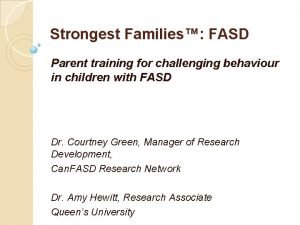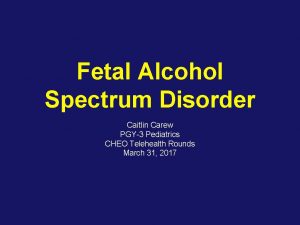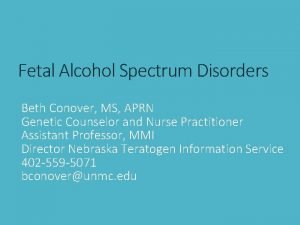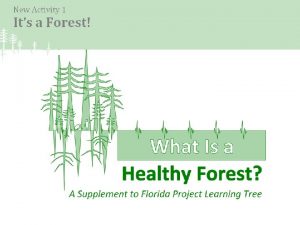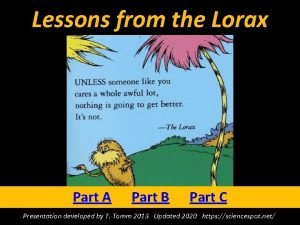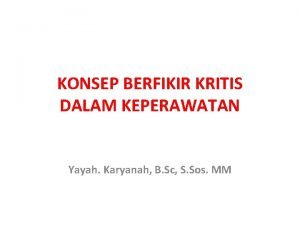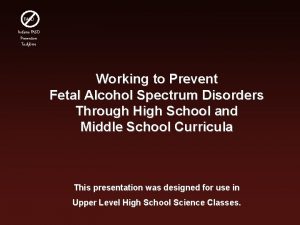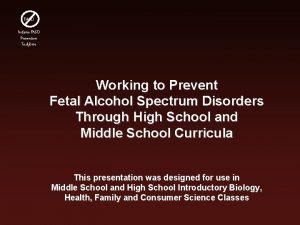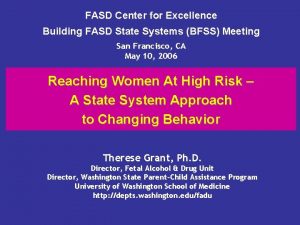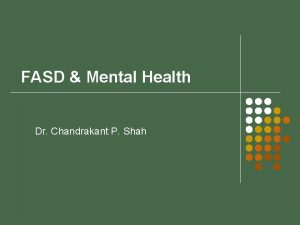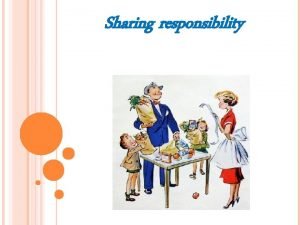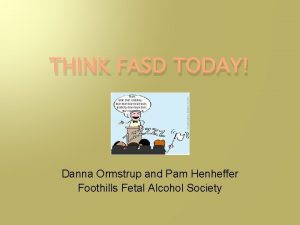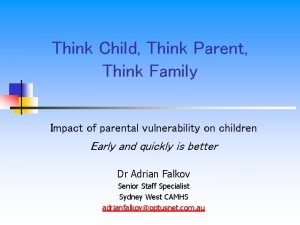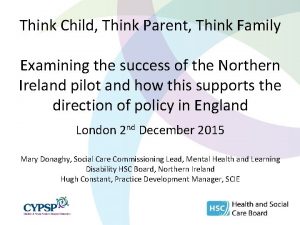FASD SHARING TOGETHER WHEN YOU THINK OF FASD
















































- Slides: 48

FASD: SHARING TOGETHER

WHEN YOU THINK OF FASD, WHAT ASSOCIATIONS COME TO MIND?

3 MYTH OR FACT? • • • Drinking alcohol is only harmful to the baby during the first trimester. Alcohol causes more damage to the developing baby than heroin does.

4 MYTH OR FACT? The effects that alcohol has on a newborn will gradually go away as the child gets older. If a mother drinks during pregnancy and her first baby is normal and healthy, it should be okay for her to drink during her second pregnancy. Women at the lowest income bracket are most at-risk to consume alcohol while pregnant. • • •

Misinterpretation Medical Personnel. Human Services Staff, Parents, Caregivers. Justice Professionals Teachers/Employers INVISIBLE DISABILITY FASD is an invisible disability, its physical characteristics can be subtle or non-existent and may go unrecognized. We cannot see brain differences so instead we see behaviours that can easily be misinterpreted.

Incidence FASDs are a major cause of preventable birth defects. . FASDs are the leading form of developmental delay in North America. One of every 100 babies born in Canada is affected by FASD.

Why care about FASD? Approximately 47, 000 Albertans currently have FASD. . 500 babies are born every year in Alberta with FASD. The estimated incidence rate is 9 individuals in 1000 births.

8 What is FASD There are two main components to understand about FASD PERMANENT FASD is a permanent birth defect that can yield a variety of intellectual, mental and biological impairments that result from in utero exposure to alcohol. This brain damage has lifelong effects. SPECTRUM FASD is a spectrum disorder; meaning it affects each person differently, depending on the time and amount of exposure to alcohol in utero. Rasmussen et al. (2012)

9 We Believe Behaviour is a symptom of the disability. Don’t make assumptions about behaviour (uncooperative, lazy…) Chronological age may not reflect developmental level. Natural and logical consequences may not work. When we fail to accommodate, we create the disability. Graeme Stuart, (2016). Seven principles for a strengths-based approach to working with groups. Sustaining Community.

10 We Believe THERE IS HOPE! Capable Families Need Support People who have Fetal Alcohol Spectrum Disorder are capable. Conversation How we talk about FASD matters. Women Need Support Women at risk of having a child with FASD also need our support. Graeme Stuart, (2016). Seven principles for a strengths-based approach to working with groups. Sustaining Community.

11 What role do MEN play in FASD prevention? Infertility Alcohol and drug use can cause infertility. Environment Once the child is born and the father continues to drink, it could have adverse affects on the developing child and a nurturing environment. Habits Although the male drinking does not directly impact the developing fetus, it can impact the drinking habits of the female carrying the fetus. Support Males who drink heavily are less likely to provide the care needed to support their pregnant partner.

12 How FASD Happens WHAT ARE THE CAUSES OF FASD? Alcohol freely gets into the fetus’ bloodstream. Alcohol in the fetus’ system takes longer to be removed. Harm can be caused before a woman knows she is pregnant. Pregnancies are exposed to alcohol at any time over the duration of pregnancy. Fetal Alcohol Spectrum Disorder (FASD) Prevention: Canadian Perspectives. (2008).

13 You may be pregnant & NOT EVEN KNOW IT The effects of alcohol on your baby can happen at any time of the pregnancy. You many not know you’re pregnant until the second trimester (4 th month of pregnancy. ) The first three months is a time where pregnancy may go unnoticed. In this time, a woman may still be drinking alcohol.

1 4 Alcohol Use In Pregnancy ZERO ALCOHOL NO RISK While no amount of alcohol during pregnancy is safe, we know that heavy drinking and binge drinking are the most harmful to the developing baby. HIGH RISK HEAVY DRINKING more than 7 drinks per week BINGE DRINKING more than 5 drinks per sitting

15 FASD is Multifactorial Stage in the pregnancy in which alcohol is consumed. The amount and pattern of alcohol consumed during the pregnancy. Maternal and fetal factors. Metabolism of alcohol (individual susceptibility). Genetics.

16 Who drinks DURING PREGNANCY? ANYONE including o Light/Moderate/Heavy drinkers o Higher income, higher education, over 30, successful o Women exposed to poverty and isolation o Multiple drug users and alcoholics o Victims of violence (childhood, domestic)

The Prevention Conversation 17

The Prevention Conversation Move the focus from a woman’s alcohol use to understanding the related health and social problems that contribute to FASD.

19 Determinants of Health We need to provide a network of supports that directly address these contributing factors Social support network Income & Social Status Biology/Genetic Endowment Health Social & Physical Services Environments Culture Gender Employment Education Population Health Branch, Health Canada.

20 Core Messages To Deliver Safest not to drink alcohol during pregnancy. Drinking can be harmful at any point during pregnancy and can result in lifelong disabilities for the child. • • • If you drink alcohol and are sexually active, it is important to use effective contraception. Some women may need support to stop drinking if they plan to become pregnant or suspect the possibility of pregnancy in the future. Friends and family can support pregnant women by encouraging healthy choices for their developing babies.

The Developing Brain AND HOW ALCOHOL AFFECTS IT Alcohol affects the size of the brain, formation of brain structures, neurochemistry and the function of the brain after birth. Exposure to alcohol can impact how and where cells in the brain develop. In some cases there may not be any cell development at all. Alcohol acts as a poison (teratogen) in the fetus’ bloodstream.

Roadways of the Brain

23 WHY ASSESS FOR FASD? 01 03 Understanding Creates a shared understanding among colleagues and an understanding between the clinician, patients and caregivers. Access Helps to access programs for support and intervention. 02 Validation The concerns of the individual, family and caregiver are validated. 04 Support Helps people with FASD and their caregivers to get the help they need.

The Diagnosis FASD with Sentinel Facial Features At-risk for Neurodevelopmental Disorder and FASD without Sentinel Facial Features

Canadian Guidelines for Diagnosis of FASD Across the Lifespan Prenatal Alcohol Exposure (PAE) Medical Assessment: family history, maternal alcohol consumption, physical examination, differential diagnosis Sentinel Facial Features Neurodevelopmental Special considerations in neurodevelopmental assessment of infants and young children Special considerations when diagnosing adolescents and adults Management and Follow-up

Brain Dysfunction CRITERIA EVIDENCE OF IMPAIRMENT ≤ (2 below the mean) in 3 or more of the following domains: Adaptive Behaviour Social Skills or Social Communication Cognition Academic Achievement Executive Functioning Affect Regulation Memory Attention Motor Skills Communication Neuroanatomy/ Neurophysiology

ADAPTIVE BEHAVIOUR, SOCIAL SKILLS OR SOCIAL COMMUNICATION Social communication domain refers to the ability to communicate appropriately and effectively in a variety of social situations with both peers and adults, including the ability to relay verbal information coherently and cohesively. Adaptation refers to the degree to which a person is able to meet the challenges of daily living when compared to others their age. ADAPTABILITY Highest percentage of all the domains affected by FASD.

28 ACADEMIC ACHIEVEMENT Achievement domain assesses skills in core academic areas such as reading, math and written language. A primary focus includes comparison of the child’s academic skills to their own intellectual potential and to their peers’ abilities. Denys, K. Kully-Martens, K. , Rasmussen, S. , Tamana, S. , & Treit, S. (2012) A Review of Social Skills Deficits in Individuals with Fetal Alcohol Spectrum Disorders and Prenatal Alcohol Exposure

29 Affect Regulation Impairment in affect regulation is present when an individual meets the DSM-5 criteria for: Major Depressive Disorder with recurrent episodes. Persistent Depressive Disorder Selective Mutism Generalized Anxiety Disorder Social Anxiety Disorder Disruptive Mood Dysregulation Disorder DMDD Separation Anxiety Disorder Panic Disorder Agoraphobia

30 ATTENTION AND COMMUNICATION ATTENTION COMMUNICATION Attention domain refers to the processing Expressive communication can be stronger capacity for selective, focused, sustained, and than receptive communication. The individual flexible attention, as seen, for example, in can express language but does not comprehend behaviors of concentration, hyperactivity and what is being communicated. impulsivity. Anderson, S. , Baldwin, M. , Chudley, Conry, J. , Cook, J. & Green, C. , (2016). Fetal Alcohol Spectrum Disorder: a Guideline for Diagnosis Across the Lifespan.

A Glimpse Y ELLO Look at the chart and W BLACK PURPL E ORANG E BLUE O RANG SAY THE COLOR NOT THE WORD BLUE E RED GREEN YELLO RED W BLACK GREEN PURPL RED E BLUE ORANG

32 Cognition and Memory COGNITION The cognition (processing) domain refers to the general level of thinking ability. An important facet of assessment in this domain is comparison of verbal with nonverbal thinking abilities. Individuals may demonstrate varied perceptions and conceptual abilities. MEMORY The memory domain encompasses the capacity to consolidate, store and retrieve information for short and long term application. Individuals may struggle remembering appointments, describing incidents, adhering to tenancy and eviction agreements and may be unaware of trauma affects. Anderson, S. , Baldwin, M. , Chudley, Conry, J. , Cook, J. & Green, C. , (2016). Fetal Alcohol Spectrum Disorder: a Guideline for Diagnosis Across the Lifespan.

MOTOR SKILLS Motor domain encompasses general abilities to use and coordinate large and small muscles. Gross motor skills include: • walking • running • hopping • climbing Fine motor skills include: • handwriting • eating Hand-eye coordination refers to the ability to coordinate vision with movement. Anderson, S. , Baldwin, M. , Chudley, Conry, J. , Cook, J. & Green, C. , (2016). Fetal Alcohol Spectrum Disorder: a Guideline for Diagnosis Across the Lifespan.

34 NEUROANATOMY/NEUROPHYSIOLOG Previous domain Brain Structure relating to the function and structure of the nervous system can affect: • fine and gross motor skills • ability to process sensory information • motor control. • balance • rhythm • strength • motor planning • sequencing. • seizure disorders Anderson, S. , Baldwin, M. , Chudley, Conry, J. , Cook, J. & Green, C. , (2016). Fetal Alcohol Spectrum Disorder: a Guideline for Diagnosis Across the Lifespan.

Misdiagnosis for Individuals with FASD • Psychotic Disorders • Bipolar Disorder • Autism Spectrum Disorder • Antisocial Personality Disorder • Reactive Attachment Disorder • Borderline Personality Disorder • Attention Deficit Hyperactivity Disorder

ENGAGING IN FASD INFORMED CARE A diagnosis of FASD is the pathway to planning. FASD informed care means that the unique and challenging neurobehavioral concerns of individuals with FASD are recognized, understood and responded to effectively. A need exists to understand reframe the behavior of individuals with FASD as brain based and not intentional. This approach supports removing blame from the person.

ENGAGING IN FASD INFORMED CARE FASD informed care means that many social and behavioral concerns are reframed. Each problem for the individual with FASD needs to be reviewed and examined from an environmental perspective. Individuals with an FASD keep making their needs very clear through their behaviors and it is critical that caregivers and caseworkers see these problems as a means to shore up the structure and responses to the individual.

38 FASD 3 8 It is not curable PRIMARY DISABILITIES Typical brain-based, primary disabilities of FASD includes: • Inconsistent MEMORY and RECALL • Decreased MENTAL STAMINA • Difficulty interpreting, and applying ABSTRACT CONCEPTS • IMPULSIVITY and poor JUDGEMENT • RESISTANT to change • Inability to PREDICT OUTCOMES • Inability to see ANOTHER PERSON’S perspective It is a spectrum It is lifelong • Inability to recognize indirect SOCIAL CLUES Centre for Addiction and Mental Health (CAMH)

Developmental Vs Chronological 3 9

Some challenges of FASD Attention Memory Language Executive Functioning Adaptive Behaviors (life skills) Regulation of Body Functions Reasoning Sensory Issues Knezovich, J. , & Ramsay, M. (2012, February). Mc. Lanahan, S. , Schneider D. & Tach L. (2013).

FASD 4 1 It is not curable SECONDARY RISKS Secondary challenges are those not present at birth, but occur later in life as a result of the primary disabilities associated with FASD. They include: • MENTAL HEALTH problems • Poor ACADEMIC achievement • Inability to live INDEPENDENTLY • ALCOHOL and/or DRUG problems • Problems with EMPLOYMENT • INCARCERATION or CONFINEMENT It is a spectrum It is lifelong • Trouble with the LAW • Disrupted SCHOOL experience Centre for Addiction and Mental Health (CAMH)

Individuals with FASD POSITIVE CHARACTERISTICS o FRIENDLY o LOVING o DEVOTED o TRUSTING o HIGHLY VERBAL o DEEP SENSE OF FAIRNESS Recognize the strengths and positive characteristics of individuals with FASD. o CURIOUS

43 Guiding Principles HOPE UNDERSTANDING COOPERATION Supportive intervention makes a difference. Stay open to new information and ideas. Recognize the importance of partnerships. RESPECT COMPASSION The abilities of all those with an FASD. Be sensitive to the needs of individuals and their families. Saskatchewan Prevention Institute (2005)

44 Who can make a difference in FASD prevention? YOU CAN!

AL 45 HO FA W FE L? ES SD AF CT U DO S Remember, FASD affects all of us!

46 The Brain Can Adapt The human brain has a remarkable ability to compensate when an area of it is injured or damaged. The ability of the brain to adapt and compensate for injury is called plasticity.

47 Guidelines for Working with Individuals with FASD 1 Keep it simple and clear. 2 Slow down and allow time to adjust to new activities and environments. 3 Allow for frequent breaks. 4 5 Focus on strengths and remember the individual’s developmental age. Connect individual with a support person. 6 Try different ways – not necessarily try harder. 7 Communicate using concrete language and examples. 8 Alter the environment. 9 Be organized. 10 Have consistent routines. Anderson, S. , Baldwin, M. , Chudley, Conry, J. , Cook, J. & Green, C. , (2016).

48 How to Help an Individual With FASD to be Successful Provide a stable, safe, structured, sober and nurturing home. Have more people understand FASD. Access support services for those affected by FASD. Obtain an FASD assessment early. Involve affected individuals and families in plans to develop supportive and social networks.
 Mukesh ambani signature
Mukesh ambani signature If you think you can you can poem
If you think you can you can poem Fasd behavior checklist
Fasd behavior checklist Fasd
Fasd Beth conover
Beth conover Vragen
Vragen Robin and jay poem
Robin and jay poem Think fam think
Think fam think So you think you can argue
So you think you can argue Choose the correct answers a-c how do you think you
Choose the correct answers a-c how do you think you So you think you can argue
So you think you can argue You are
You are What comes to mind when you hear the word family?
What comes to mind when you hear the word family? You have more potential than you think
You have more potential than you think What do you think of when you hear the word science?
What do you think of when you hear the word science? What do you think of when you hear
What do you think of when you hear So you think you can argue
So you think you can argue When sharing the road with a light rail vehicle you
When sharing the road with a light rail vehicle you Instrument you hit together
Instrument you hit together Song
Song Describe mayella's injuries
Describe mayella's injuries Mass density volume
Mass density volume What do you think happened in the image
What do you think happened in the image What are people doing in the picture
What are people doing in the picture Think before you dig
Think before you dig The cask of amontillado questions
The cask of amontillado questions Being a clown isn't all fun and games summary
Being a clown isn't all fun and games summary What do you think the text is about
What do you think the text is about Rules of netiquette in ict
Rules of netiquette in ict Oh the thinks you can think quotes
Oh the thinks you can think quotes They provide information to media users
They provide information to media users Lorax worksheet answers
Lorax worksheet answers New ideas and creativity adalah
New ideas and creativity adalah I think you should be more specific here in step two
I think you should be more specific here in step two Think before you lift
Think before you lift God is closer than you think
God is closer than you think Describe how dog horse and ox turned against the man
Describe how dog horse and ox turned against the man List details you think are mexicano contributions
List details you think are mexicano contributions What is happening in this photo
What is happening in this photo What comes to your mind when you think about god
What comes to your mind when you think about god What do you think was askia's greatest accomplishment?
What do you think was askia's greatest accomplishment? How does katniss react to peeta’s declaration of love?
How does katniss react to peeta’s declaration of love? Metamorphosis activity
Metamorphosis activity In pairs discuss the following questions
In pairs discuss the following questions I owe you a sorry
I owe you a sorry Types of facility layout
Types of facility layout Do you think jackson’s indian policy promoted democracy
Do you think jackson’s indian policy promoted democracy D) in pairs, discuss the following topics:
D) in pairs, discuss the following topics: Answer the questions in pairs
Answer the questions in pairs


